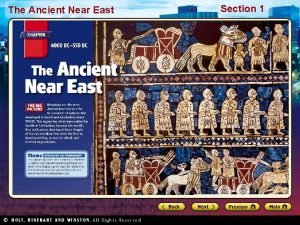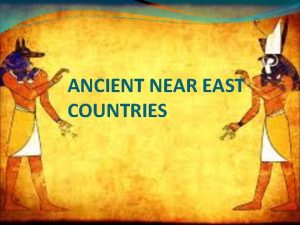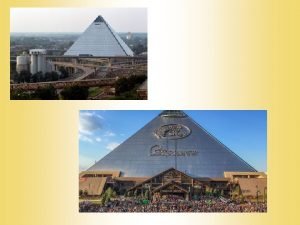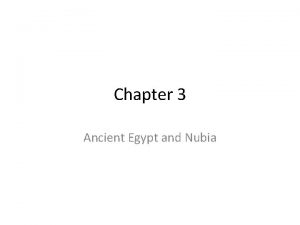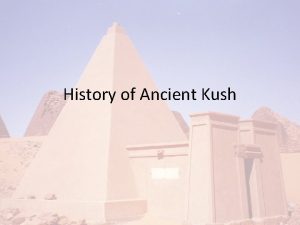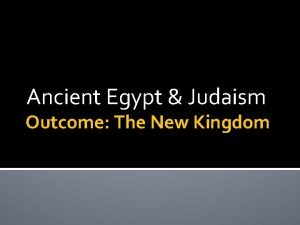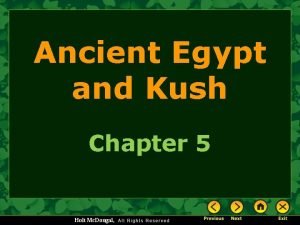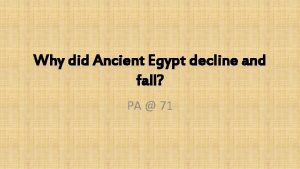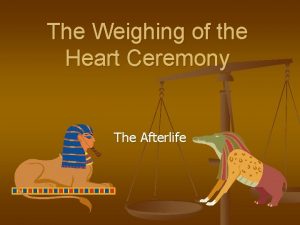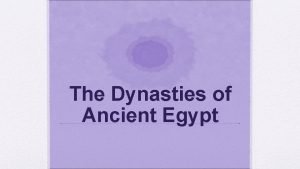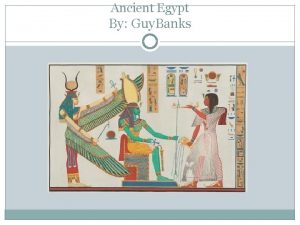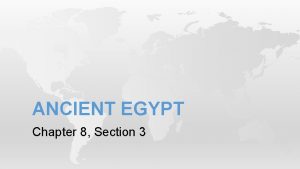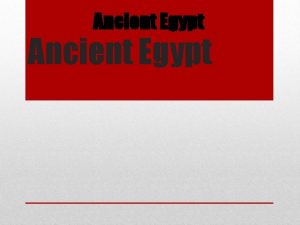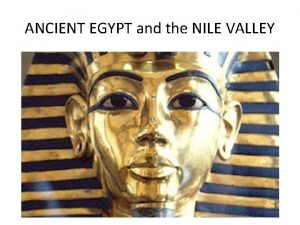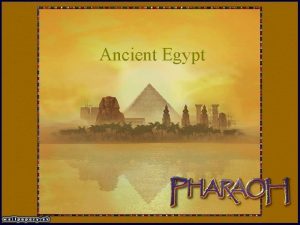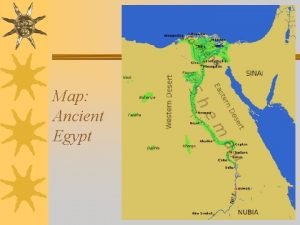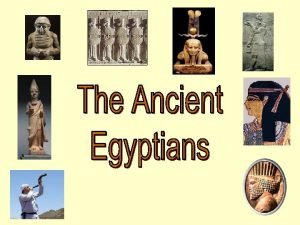Egypt Chapter 1 The Ancient and Near East















- Slides: 15

Egypt Chapter 1 The Ancient and Near East: The First Civilizations

Ancient Egypt

Nile River

Old and Middle Kingdom Upper and Lower Egypt united, 3100 B. C. Old Kingdom, 2700 -2200 B. C. • Divine kingship • Ma’at-spiritual precept that conveyed truth, justice, right order and harmony. • Administration • The greatest and largest pyramid in Egypt’s history was constructed at this time. Middle Kingdom, 2050 -1650 B. C. King of Thebes, Mentuhotep (2200 -2050 B. C. ) reunified all of Egypt thus beginning the middle Kingdom. The middle kingdom was thought of as an golden age of stability and vitality

Society and Economy in Ancient Egypt Organized along hierarchical lines, god -king at the top • Upper class nobles and priests • Merchants and artisans s Active trade • Lower classes largest number of people and they worked the land. • Slaves

Culture of Egypt Spiritual life in Egyptian Society • Religion- worshiped a large number of Gods Osiris and Seth- myth of struggle between Osiris and Seth. Osiris was the symbol of resurrection and judge of the dead. The dead, were embalmed and mummified and placed in tombs and given his name. In hopes of being reborn. Book of the Dead The dead were asked to give an account of their earthly deeds to show whether they deserved a reward. Magical incantations from the book of the dead were used to ensure a favorable journey to a happy afterlife.

The Pyramids A city for the dead – The tombs were well prepared for the residents, they were furnished and stocked with numerous supplies, including chairs, boats, chests, weapons, games, dishes, and a variety of foods. The belief was that human beings had two bodies, a physical one and a spiritual one, which they called the ka. If the physical body was properly preserved or mummified and the tomb furnished with objects of regular life, then the ka could return and continue its life despite the death of the body. Pyramids the tombs for mummified bodies First pyramid, King Djoser, Third Dynasty The great pyramid at Saqqara

The largest of the three pyramids is the Great Pyramid of Khufu. The next one is the Pyramid of Khafre and the smaller is Memkaure.

The Great Pyramid of Giza is the main part of a complex setting of buildings that included two mortuary temples in honor of Khufu (one close to the pyramid and one near the Nile), three smaller pyramids for Khufu's wives, an even smaller "satellite" pyramid. Height: 481 ft. Originally now 449 Base: 13 square acres, or 7 city blocks Worlds tallest from 2570 to 1300 AD. Location Giza, Egypt Constructed c. 2570 BC Total blocks of stone: 2, 300, 000

The Sphinx Built by the 4 th Dynasty King, Khafre (25582532 BCE).

Art and writing Art was functional Paintings and statues serve a spiritual purpose Hieroglyphs- sacred characters used as picture signs that depicted objects.

Chaos and a New Order: New Kingdom, 1567 -1085 B. C. • Tutmosis I (1524 -1518) expanded Egypt’s border to south by conquering the African kingdom of Nubia. • Tutmosis III, c. 1480 -c. 1450 B. C. - led 17 military campaigns into Palestine and Phoenicia. The Egyptians occupied these lands but permitted local native princes to rule.

Hatshepsut, 1473 -1458 B. C • Married her half-brother, Thutmose II. • When Thutmose II died in 1479 B. C. his son, Thutmose III, was appointed heir. She became the regent. • They ruled jointly until 1473 when she declared herself pharaoh. • She dressed in men’s attire, • She built a magnificent temple at Deir el Bahari in Thebes. • Hatshepsut disappeared in 1458 B. C. when Thutmose III, wishing to reclaim the throne, led a revolt. Thutmose had her shrines, statues and reliefs mutilated.

Religious Change and the End of the Empire Amenhotep III, c. 1412 -1375 B. C. Amenhotep IV (Akhnaton), c. 1364 -1347 B. C. Introduced the worship of Aten. Tutankhamen, 1347 -1338 B. C. -His tomb was found almost intact by Howard Carter in 1922. Rameses II, c. 1279 -1213 B. C.

Daily Life in Ancient Egypt Life Span- 25 -30 years old Women-Women's’ property and inheritances remained in their hands even in marriage. Marriages- arranged-They could end in divorce, adultery was strictly prohibited and punishments were severe especially for women, who could have their noses cut off or be burned at the stake. Entertainment • Music • Hunting was a sport enjoyed by men using chariots and dogs and a bow and arrow. • Fowling- Using a reed skiff, the huntsman used a boomerang to bring down his prey. Then a trained cat would swim out and retrieve the fowl.
 Near east vs middle east
Near east vs middle east Early empires in the ancient near east
Early empires in the ancient near east The ancient near east
The ancient near east Ancient near east countries
Ancient near east countries Physical activities of the primitive society
Physical activities of the primitive society Upper egypt and lower egypt
Upper egypt and lower egypt Map of ancient egypt and nubia
Map of ancient egypt and nubia Kush kingdom map
Kush kingdom map Ancient egypt and judaism outcome the new kingdom
Ancient egypt and judaism outcome the new kingdom Map of egypt and kush
Map of egypt and kush Near east university tourism and hotel management
Near east university tourism and hotel management Near hip near shoulder tackling
Near hip near shoulder tackling What does ancient egypt
What does ancient egypt Anubis weighing of the heart ceremony
Anubis weighing of the heart ceremony Early american floral arrangements
Early american floral arrangements Ancient egypt vocabulary words
Ancient egypt vocabulary words


